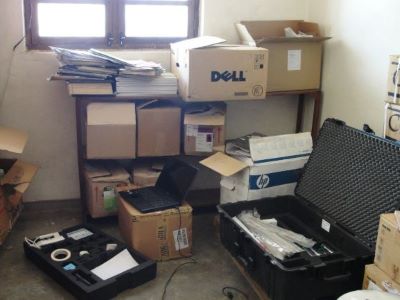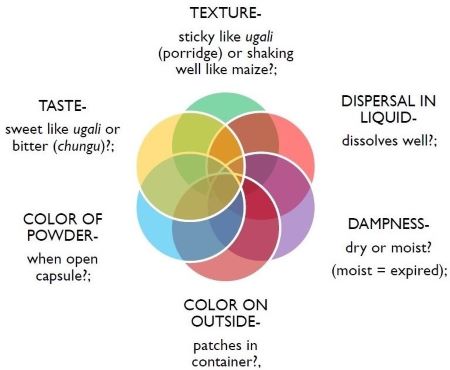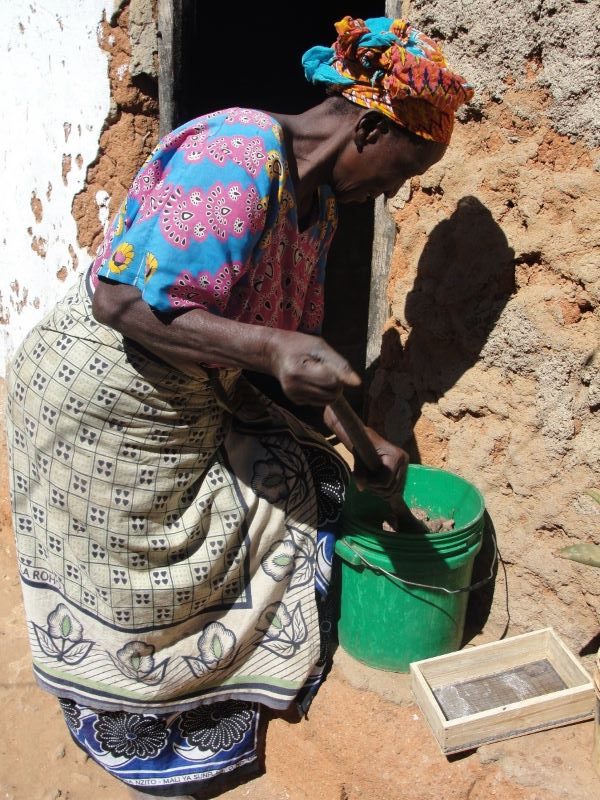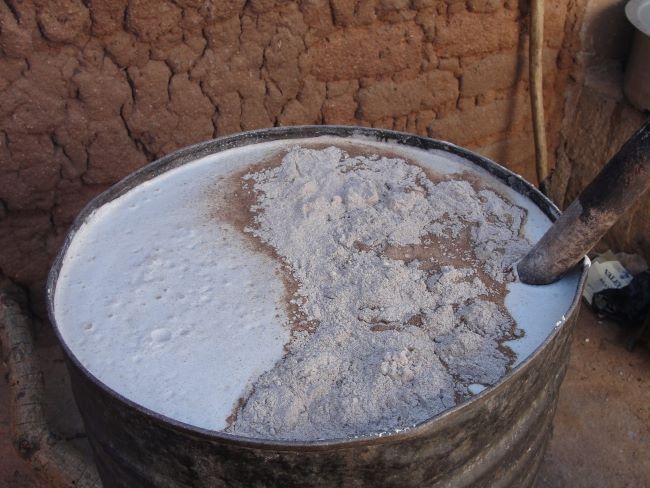When I originally arrived to start fieldwork in the Southern Highlands of Tanzania, I set out to observe the scientific practices through which counterfeit drugs were identified at the regional hospital.[1] I knew, from previous fieldwork, that the hospital had a mini-lab for conducting a Thin-Layer Chromatographic Test. Two years passed before I was finally able to observe this test; one of the reasons was that the hospital was out of the iodine detection reagent needed to carry it out. During the ensuing years, I came to learn that science was happening elsewhere; not always in the laboratory or hospital, but—perhaps even more frequently—in the home, marketplace, and workshop.[2]

Thin-Layer Chromatographic (TLC) test at a regional
government hospital in Tanzania. (Credit: Laura Meek.)
A kind of radical empiricism informs the practices of my interlocutors who experiment with the capacities of pharmaceuticals, often to discern which drugs are counterfeit. I encountered HIV-positive patients exchanging their moist antiretrovirals for dry capsules and sleuthing hospital nurses who were peeling back labels to investigate dubious drugs. I understand these practices for detecting adulterated pharmaceuticals as a form of embodied epistemology, entailing a deep knowledge of the material, sensory, and aesthetic qualities of drugs. A Euro-American understanding of the senses as merely the passive recipients of data is insufficient here, as the senses also participate in the active construction of knowledge, enabling “a direct material engagement” with the world “where part of the world becomes differentially intelligible to another” (Barad 2007: 377).
Embodied Experimentation as Fugitive Science
As my relationships in Iringa, Tanzania deepened over time, friends began contacting me to tell me about various other pharmaceutical experimentations in the community. These practices ranged from the use of phenobarbital by vernacular healers to cool down the heat of a bewitched body to the fattening of livestock with antiretrovirals pills. It was from a close friend that I also came to learn about experiments with antibiotics in the fermentation of locally brewed beer. In referring to this practice as a fugitive science, I draw upon literature in Black Studies which emphasizes fugitivity to foreground “the tension between the acts or flights of escape and creative practices of refusal” (Campt 2014 quoted in Sojoyner 2017: 516). The concept of ‘fugitive science’ comes from the work of historian Britt Rusert (2017), who coined the term to describe the everyday experimental practices of African Americans in the antebellum period, including the ways in which they engaged in experimentation to challenge the prevailing racist science of the day.[3] The beer brewers I spent time with were similarly engaged in creative and furtive practices, operating against the long durée of constriction and enclosure.
Experimentation with drugs is surveilled and regulated by various actors, ranging from state agencies to global health organizations. NGOs pressure the Tanzanian state to adopt what the global health community views as appropriate requirements for the use and regulation of pharmaceuticals, which has led to new measures aimed at tightening regulations on pharmaceutical sales. Such regulatory apparatuses rely entirely on Western assumptions about what pharmaceuticals are, what gives them their potency and capacities, and how these transformative effects ought rightly to be deployed. My research complicates these presumptions, in part by challenging the containment of ‘science’ within spaces of global capital and the neoliberal university.

Diagram of embodied knowledge about the qualities of pharmaceuticals in Tanzania. For an expanded description see the following note. [4] (Credit: Laura Meek. )
Part of the political significance of this fugitive science in Tanzania today lies in the fact that Africans have long been—and continue to be—the objects of Western scientific experiments. Historian Helen Tilley describes colonial Africa as a “living laboratory” of scientific research, development experiments, and social engineering (2011). In contemporary Tanzania, clinical trials are conducted on populations who will almost certainly never be able to afford the medicines their bodies bring to the market. Meanwhile, following the Enlightenment tradition’s hierarchical construction of race, African knowledges were described by early anthropologists as ‘mystic’, ‘intuitive’, ‘practical’, ‘sensuous’, ‘superstitious’, ‘experiential’—but never ‘scientific’. The “‘natives’ became samples, specimens, data, and, at best, informants, rather than intellectual agents in their own right” (Mavhunga 2018: 14). Against this backdrop, I read the experiments of my interlocuters as creative (and furtive) forms of resistance to their relation to science as merely its objects.[5]
Constriction & Enclosure of Beer Brewing
The locally-brewed beer komoni has long been central to the life of the local Hehe community, playing a crucial role in social gatherings like funerals and weddings, and comprising the most important offering to ancestors. Brewing komoni is understood to be one of the mambo ya wanawake, or women’s matters, and all of the brewers I spent time with were women.

Mama Adla adding antibiotics to komoni. (Credit: Laura Meek)
Brewing komoni became furtive and illicit during the British colonial period (1919-1961), when officials were durably preoccupied with local beer-brewing; they implemented dozens of policies to regulate and tax komoni.[6] In the mid–20th century, the colonial government—through their policy of indirect rule—pressured the head of the Native Authority for the Hehe to sign an ordinance that made it illegal to sell komoni without a license. Colonial authorities only administered licenses to 30 women within a three-mile radius of Iringa, forcing most brewers to work in secret (TNA 1943-1952).
Today, women who brew komoni continue to face regulations that make their work precarious, perilous, and arduous. For instance, collecting branches for firewood is illegal in the reserves around town and the brewers I spent time with had to sneak out to collect wood in secret, often in the middle of the night.
Reconfiguring Pharmaceutical Capacities
Women brew several different kinds of fermented drinks in Iringa, but the most iconic and popular is komoni, a beer made primarily from maize (mahindi) and finger millet (ulezi). The process of brewing komoni takes days and requires constant attention: it is both a fugitive science and an art. Mama Adla, who is well-known for her beer-brewing skills, patiently taught me her process.[7] The togwa (the sweet part of the beer) is brewed in a large tin container on a wood fire, while the komba (the potent portion) ferments in a clay pot. The flavor must be fermented slowly and crafted carefully; this is captured by the word for fermenting in Swahili—kuamsha—which literally means ‘to awaken’.

The togwa fermenting/awakening (kuamsha). (Credit: Laura Meek.)
When foam forms on the top of the togwa, both concoctions can be combined. If the mixture become too strong, Mama Adla might add ashes from burnt firewood to cut some of the uchachu (sourness). Other times, the mixture may taste too sweet (tamu). In this case, brewers used to add the bitter leaves of mchunga. This plant is not cultivated; it is harvested in the wild and grows essentially as a weed, but, like firewood, is becoming harder and harder to find due to urbanization. Experimenting with alternatives, brewers have begun to use another bitter substance instead, one which is quite plentiful: the antibiotic chloramphenicol. Mama Adla opens capsules of the drug and pours them into the komba after it ferments. She describes the purpose of this as: “kuongeza makali zaidi kwenya komba” (to increase the strength of the komba).
Antibiotics work well, Mama Adla told me, because they taste very bitter. Across a wide range of practices in Tanzania—from culinary to ritual to medicinal—bitterness is a quale that indexes the capacity to transform.[8] It agitates, activates, and precipitates a change of state. For instance, in some areas mchunga is used as a treatment for diabetes (which, in Swahili is called kisukari from the word for sugar, sukari). Notice here that a plant named for its bitterness treats a disease named after sugar. Sensory qualities index the transformative capacities of substances. Enacted within this onto-epistemic assemblage, pharmaceutical efficacy is reconfigured in ways that exceed biomedical “active ingredients”. In fact, other material-semiotic qualities of drugs—such as their bitter taste—become the “active” ingredient for practices like brewing komoni.
This was brought home to me one day when I discovered that the capsules Mama Adla was using to brew her komoni (from the brand Chlorosim) were probably counterfeit. I suspected this after having searched an online government database of registered pharmaceutical brands in Tanzania and seeing that the manufacturer of Chlorosim was nowhere listed. When I approached her about it, Mama Adla laughed at my presumption that this mattered. What difference could it make if a particular ingredient was present or not, or in the dose required by some regulatory agency? What mattered was that the powder inside the capsules tasted chungu enough. After all, the uchungu (bitterness) is the active ingredient for the practice of beer brewing.
In experimenting with different additive agents, including pharmaceuticals, brewers radically reconfigure the capacities of such substances in ways that exceed biomedical frameworks. The nature of ‘counterfeit’ is also imploded and made anew, as a given pharmaceutical might be considered fake when engaged in one set of practices, yet might be taken as a genuine artifact when practiced otherwise. As Mama Adla taught me, the capacities of pharmaceuticals are not necessarily given ontologically in their chemical or material make-up but are enabled, even created, by the conditions of their use. Mama Adla’s fugitive science is thus a “nimble and strategic” (Campt 2014 quoted in Sojoyner 2017: 516) tinkering that both rejects the singularity of Western biomedical epistemology and enables certain forms of sociality against the grain of enclosure and social death.
Notes
[1] The World Health Organization asserts that Sub-Saharan Africa is most affected by counterfeit pharmaceuticals, with estimates that 30-60 percent of drugs are adulterated. The issue of counterfeits is a central concern in the news and popular discourse in Tanzania, as are the efforts of pharmaceutical corporations to control that illicit market and the “war on counterfeits” being articulated (and occasionally waged) by the neoliberal Tanzanian state. What I was primarily interested in during my fieldwork is how my interlocuters identify fakes, classify qualities of drugs, and respond to these uncertain conditions.
[2] From 2011-2018, I conducted approximately three years of ethnographic fieldwork in Iringa, Tanzania, a regional capital in the Southern Highlands with a population of approximately 113,000 people. As I investigated the social dynamics and concerns that inform pharmaceutical use there, I found that complexly nuanced understandings of the characteristics and uses of drugs circulate widely and constitute a form of knowledge that at times includes, but also transcends, that of biomedicine and global health.
[3] The scientific interventions Rusert describes were conducted by nonprofessional scientists, writers, artists, and performers; took place in spaces like gardens, churches, parlors, and on stage; and drew upon diverse forms of empiricism, such as craniology, mesmerism, astrology, and conjuring (Rusert 2017).
[4] This image depicts a diagram with seven overlapping, splayed out circles, each of a distinct color. The circles are labeled, clockwise from the top: “TEXTURE – sticky like ugali (porridge) or shaking well like maize?; DISPERSAL IN LIQUID – dissolves well?; DAMPNESS – dry or moist? (moist = expired); COLOR ON THE OUTSIDE – patches in contained? COLOR OF POWDER – when open capsule?; TASTE – sweet like ugali or bitter (chungu)”
[5] I define ‘science’ capaciously as all forms of radical empiricism. Thinking also with Deleuze & Guattari’s writing on “minor science” (1987[1980]), I refer to this experimentation as ‘radical’ to capture how it opens bodies, practices, and drugs to new potentialities—augmenting reality—rather than classifying and reducing what is (or might be).
[6] For instance, in 1927, the Deputy Director of Sanitary Services wrote: “I therefore recommend…that the Government should take over control of the female brewers…[and that there should be] a real brewery with a European brewer in charge” (TNA 1927-1939). This disenfranchising of female brewers continues in file after file in the Tanzania National Archives.
[7] Mama Adla is a pseudonym.
[8] Quale (the singular of ‘qualia’) is a term I borrow from the work of Nancy Munn (1986). ‘Qualia’ as a concept captures how the qualities of things are semiotically informed aspects of the social, rather than merely individual subjective experiences
Bibliography
Barad, Karen. 2007. Meeting the Universe Halfway: Quantum Physics and the Entanglement of Matter and Meaning. Durham, NC: Duke University Press.
Campt, Tina. 2014. “Black Feminist Futures and the Practice of Fugitivity.” Helen Pond McIntyre ’48 Lecture, Barnard College, October 7.
Deleuze, Gilles, & Félix Guattari. 1987[1980]. A Thousand Plateaus. Minneapolis, MN: University of Minnesota Press.
Mavhunga, Clapperton Chakanetsa. 2018. The Mobile Workshop: The Tsetse Fly and African Knowledge Production. Cambridge, MA: MIT Press.
Munn, Nancy. 1986. The Fame of Gawa: A Symbolic Study of Value Transformation in a Massim (Papua New Guinea) Society. Durham, NC: Duke University Press.
Rusert, Britt. 2017. Fugitive Science: Empiricism and Freedom in Early African American Culture. New York, NY: New York University Press.
Sojoyner, Damien M. 2017. Another Life Is Possible: Black Fugitivity and Enclosed Places. Cultural Anthropology 32(4): 514-536.
Tanzania National Archives. 1927-1939. Native Beer. File 767.300, Ministry of Health Records. Accession No. ACC 450.
Tanzania National Archives. 1934-1952. Liquor- Native Liquor Prohibition. File 30/3, Iringa Region Records Book. Accession No. ACC 24.
Tilley, Helen. 2011. Africa as a Living Laboratory: Empire, Development, and the Problem of Scientific Knowledge, 1870-1950. Chicago, IL: The University of Chicago Press.

2 Trackbacks